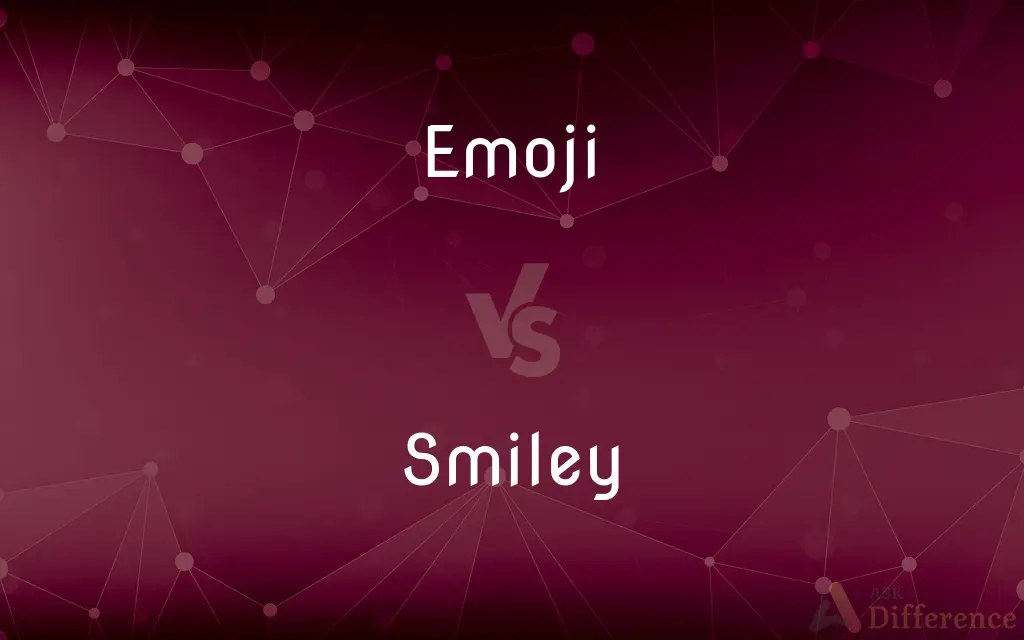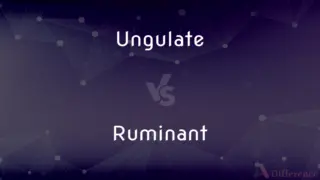Emoji vs. Smiley — What's the Difference?
By Tayyaba Rehman & Fiza Rafique — Updated on April 15, 2024
Emojis are digital icons representing emotions, objects, or symbols across various platforms, while smileys are stylized representations of smiling faces used to convey emotion.

Difference Between Emoji and Smiley
Table of Contents
ADVERTISEMENT
Key Differences
Emojis encompass a wide range of icons that go beyond facial expressions to include animals, plants, symbols, and more, allowing for detailed and diverse communication in digital messages. On the other hand, smileys specifically refer to stylized versions of smiling faces, traditionally used to express happiness or other simple emotions in text.
While emojis are standardized by the Unicode Consortium, ensuring they appear consistently across different devices and platforms, smileys can vary greatly in style from simple text representations like ":)" to more graphical interpretations.
Emojis offer a broad spectrum of emotions and concepts, which can be used to enhance and clarify the meaning of messages. Smiley, on the other hand, is generally limited to conveying basic emotional tones, often just variations of happiness or friendliness.
In terms of usage, emojis are integrated into the keyboards of most modern digital devices, providing users with easy access to these symbols. In contrast, smileys, especially text-based ones, require users to remember specific sequences of characters.
Finally, emojis have been embraced by cultures worldwide and have even influenced modern communication, art, and media. Smiley faces, while also globally recognized, maintain a more niche and focused role in representing emotions.
ADVERTISEMENT
Comparison Chart
Definition
Digital icons of emotions, objects, or symbols
Stylized representations of smiling faces
Scope
Wide, includes various objects and symbols
Narrow, primarily faces expressing emotions
Standardization
Standardized by Unicode
No formal standardization
Expression Variety
Extensive, multiple emotions and concepts
Limited, mostly variations of happiness
Integration
Built into digital device keyboards
Often requires typing specific character sequences
Compare with Definitions
Emoji
A small digital image or icon used to express an idea or emotion in electronic communication.
The heart emoji is often used to express love.
Smiley
A graphical representation of a smiling face, used in communication to express happiness.
Smiley faces brighten up any casual conversation.
Emoji
Emojis help convey tone and gestures in text, similar to body language in personal communication.
The thumbs-up emoji signifies approval.
Smiley
Originally created from punctuation marks in text form, like ":)" or ":-)".
Typing a simple smiley can quickly show friendliness.
Emoji
Emojis are updated and expanded regularly to include new symbols that reflect current trends and cultural events.
The recent addition of the vaccine emoji amidst the pandemic.
Smiley
Smiley usage predates modern emojis and was initially used to convey mood in plain text communications.
Email and early internet users heavily utilized smileys.
Emoji
Emojis can depict a wide range of real-world objects, like animals and food items.
The pizza emoji is popular on food-related posts.
Smiley
Despite the rise of emojis, traditional smileys continue to be popular due to their simplicity and clarity.
Many people still prefer text-based smileys in informal texts.
Emoji
Emoji symbols include activities, weather conditions, and flags.
The soccer ball emoji is used during discussions about sports.
Smiley
Smiley faces have evolved to include various expressions of emotions but typically focus on positive sentiments.
Winking and laughing smileys are popular variations.
Emoji
Emoji or Emojis ( i-MOH-jee; from Japanese 絵文字 [emodʑi] lit. 'picture character'; plural emoji or emojis) are pictograms, logograms, ideograms and smileys used in electronic messages and web pages. The emoji's primary function is to fill in emotional cues otherwise missing from typed conversation.
Smiley
A smiley, sometimes referred to as a smiley face, is a basic ideogram that represents a smiling face. Since the 1950s it has become part of popular culture worldwide, used either as a standalone ideogram, or as a form of communication, such as emoticons.
Emoji
A small digital image or icon used to express an idea or emotion
Emoji liven up your text messages with tiny smiley faces
Smiley
Smiling; cheerful
He drew a smiley face
Emoji
A standardized ideogrammatic icon, as of a face or a heart, used especially in electronic messages or on webpages.
Smiley
A symbol representing a smiling face that is used in written communication to indicate that the writer is pleased or joking.
Emoji
Such icons considered collectively.
Smiley
An emoticon, especially a smiling facial glyph [ :-) ] used to express delight or to indicate humor or irony.
Emoji
A digital graphic icon with a unique code point used to represent a concept, object, person, animal or place, originally used in Japanese text messaging but since adopted internationally in other contexts such as social media. Or, by extension, any non-standard emoji-like image inserted inline in text, i.e. an image emoticon.
Smiley
Having a cheerful and happy disposition; smiling.
Smiley
Cheerful and happy; smiling.
Have a smiley demeanor
A very smiley girl
Smiley
(slang) Having one's throat slit from side to side.
Smiley
A simplified representation of a smiling face.
Smiley
(Internet) A sequence of text characters used to represent a happy mood, especially :)]] or :-)]] or other depiction of smiling.
Smiley
(rare) An improvised street weapon consisting of a length of chain with padlocks and other heavy objects affixed to one end.
Smiley
(South Africa) A roasted sheep's head.
Smiley
The type of piercing of the upper frenulum (upper lip).
Smiley
An emoticon of a smiling face
Common Curiosities
How do emojis differ from smileys?
Emojis cover a broader range of symbols and are standardized, whereas smileys are generally limited to representing emotions, particularly happiness.
What is a smiley?
A smiley is a stylized representation of a smiling face used to convey emotion, primarily happiness.
Are smileys still popular?
Yes, smileys remain popular, especially in informal communication where quick and clear emotional expressions are needed.
Why are emojis standardized?
Emojis are standardized by the Unicode Consortium to ensure they appear consistently across different platforms and devices.
Can emojis replace words in communication?
Yes, emojis can replace words or phrases to convey messages succinctly and visually.
What is the most commonly used emoji?
Commonly used emojis include the face with tears of joy, red heart, and thumbs-up symbols.
Are there any cultural differences in how emojis are used?
Yes, the interpretation and popularity of certain emojis can vary significantly across cultures.
What was the original purpose of smileys?
The original purpose of smileys was to convey emotions in text-based communication, helping to prevent misunderstandings.
What is an emoji?
An emoji is a digital symbol used to express emotions, ideas, or objects in electronic communications.
What is the difference between a text-based smiley and a graphical smiley?
Text-based smileys are created with characters from the keyboard, while graphical smileys are visual icons.
Can the meaning of emojis change over time?
Yes, the meanings of emojis can evolve based on how people use them and changes in cultural contexts.
Why might someone choose to use a smiley over an emoji?
Someone might choose a smiley for simplicity, clarity, or to maintain a more traditional or nostalgic tone in communication.
How have emojis impacted digital communication?
Emojis have greatly enriched digital communication, allowing for more expressive and nuanced conversations.
Do all digital devices support emojis?
Most modern digital devices support emojis, although the available range may vary by platform and software version.
How are new emojis created?
New emojis are proposed and reviewed by the Unicode Consortium, which decides on new additions based on various criteria including widespread need and potential usage.
Share Your Discovery

Previous Comparison
Tamil vs. Malayalam
Next Comparison
Ungulate vs. RuminantAuthor Spotlight
Written by
Tayyaba RehmanTayyaba Rehman is a distinguished writer, currently serving as a primary contributor to askdifference.com. As a researcher in semantics and etymology, Tayyaba's passion for the complexity of languages and their distinctions has found a perfect home on the platform. Tayyaba delves into the intricacies of language, distinguishing between commonly confused words and phrases, thereby providing clarity for readers worldwide.
Co-written by
Fiza RafiqueFiza Rafique is a skilled content writer at AskDifference.com, where she meticulously refines and enhances written pieces. Drawing from her vast editorial expertise, Fiza ensures clarity, accuracy, and precision in every article. Passionate about language, she continually seeks to elevate the quality of content for readers worldwide.
















































